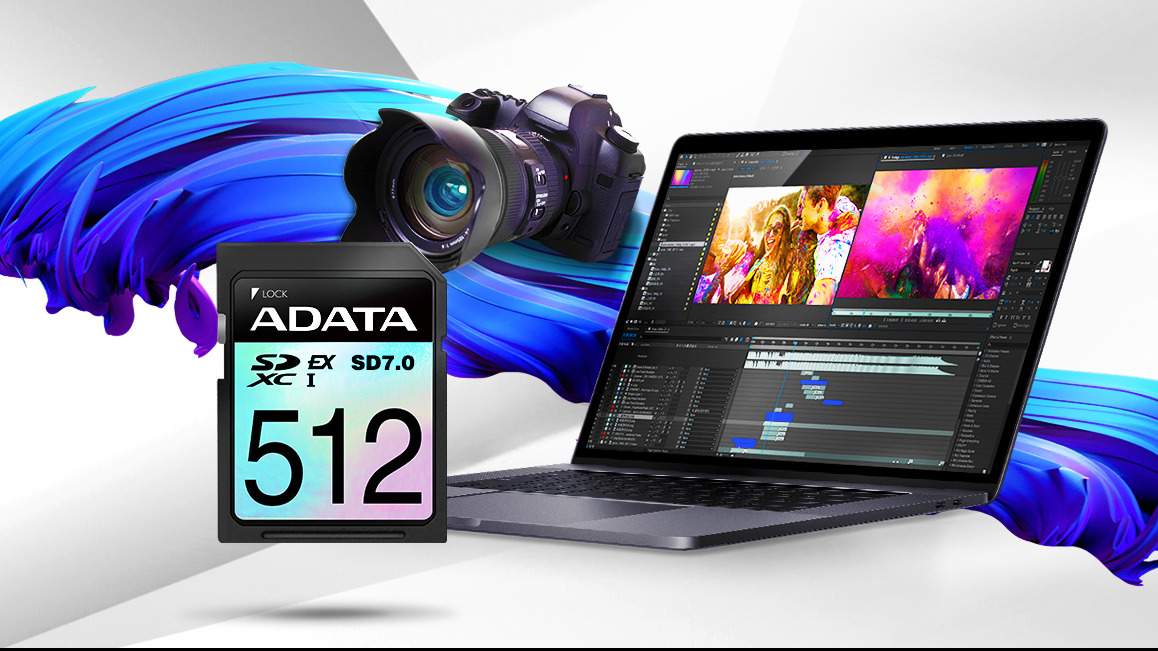First SD Express 8.0 memory card from Adata hits 1.6 GB/s read speeds — 512GB capacity, and U3/V30 compliant

Adata has unveiled what it claims is the industry's first SD Express 8.0 compliant card, boasting read and write speeds of 1.6 GB/s and 1.2 GB/s, respectively. These numbers are up to twelve times faster than existing UHS-1 solutions, four times the speed of UHS-II, and even beat out several entry-level NVMe SSDs. The Premier Extreme SD 8.0 Express memory card will debut with a single 512GB storage option, but we're likely to see higher-capacity offerings spring up as the technology and market matures.
The SD Express technology was introduced back in 2018, with the SD 7.0 standard. However, we're only seeing these superfast cards become a reality now, in 2025, largely due to the Nintendo Switch 2. SD Express cards function a lot like the SSDs in your PC/PS5/Xbox, utilizing PCIe lanes and the NVMe protocol. Even entry-level SD Express cards are rated for a theoretical maximum bus speed of 985 MB/s (PCIe 3.1 x1). This number gets progressively higher, with PCIe 4.0 x2-based cards capable of hitting 4 GB/s under the SD 8.0 standard.
Adata's Premier Extreme lineup is being expanded with an SD Express 8.0 option, featuring a PCIe 3.0 x2 interface, advertised with read and write speeds of 1.6 GB/s and 1.2 GB/s. Despite the impressive claims, keep in mind that the card's U3 and V30 ratings only guarantee a minimum sustained write speed of just 30 MB/s. With its 512GB capacity, the Adata Premier Extreme SD Express offers built-in LPDC ECC technology and support for multi-device simultaneous access.
SD Express card ratings
SD Express cards have their own speed rating indicated by an 'E' and a number. For example, E150 on an SD Express card means you're guaranteed a sustained write speed of 150 MB/s. The majority of SD Express cards currently available in the market have not been specified with these ratings, falling back to the traditional U3/V30 speed class.
Sadly, these cards won't find much use outside the Switch 2 and professional video gear, as almost all smartphone manufacturers have abandoned the concept of expandable storage. Implementing SD Express in phones would mean adding a unique connector and sacrificing a few PCIe lanes off the SoC. So, we'll probably be stuck with internal non-upgradeable UFS and NVMe (iPhones) storage for the time being.
Similarly, MicroSD Express cards are not cheap, costing up to 25 cents per GB, compared to retail SSDs, which can be had for 5-6 cents per GB. Given that both are based on the same NAND flash storage technology, the cost of SD Express based memory cards is likely to decrease over time. Adata has not specified a price or a release window for this memory card, but we expect to hear more at Computex next month.
Get Tom's Hardware's best news and in-depth reviews, straight to your inbox.

Hassam Nasir is a die-hard hardware enthusiast with years of experience as a tech editor and writer, focusing on detailed CPU comparisons and general hardware news. When he’s not working, you’ll find him bending tubes for his ever-evolving custom water-loop gaming rig or benchmarking the latest CPUs and GPUs just for fun.
-
bkuhl I saved for a bit back in like 2011 when SSDs where like $500 for a 256GB model... Picked up an Adata drive and could not get my Mac Pro to recognize it for Mod Edit]. Finally gave up and brough it back to Microcenter and they were like... we get a lot of these DOA.Reply
Saved a bit more and picked up a Micron and swore off anything from Adata ever since.... -
YSCCC The SD Express, unlike CF express basically have no market after so many revisions, mainly due to the form factor lack of backward compatibility and will be very slow if used in a non sd express slot, and seems the real potential usecase I can think of are the higher end mirrorless cameras or pro video cameras, which normally have a CF express slot serving the need of high speed raw images, and the UHS-II is more than enough as a backup slot. for the rest of use case, the high cost and need to re purchase all the card readers are pure inhibiting adotion from manufacturers and without compatible gear, it will be hard to take up the momentumReply -
Heiro78 Reply
Not to mention the lack of microSD slots in most mainstream mobile phones.YSCCC said:The SD Express, unlike CF express basically have no market after so many revisions, mainly due to the form factor lack of backward compatibility and will be very slow if used in a non sd express slot, and seems the real potential usecase I can think of are the higher end mirrorless cameras or pro video cameras, which normally have a CF express slot serving the need of high speed raw images, and the UHS-II is more than enough as a backup slot. for the rest of use case, the high cost and need to re purchase all the card readers are pure inhibiting adotion from manufacturers and without compatible gear, it will be hard to take up the momentum -
YSCCC Reply
I believe for the memory cards the main market they will be in are the big mirrorless/DSLR/Videocam market, those are the ones which need a portable card with quick read/write speed to not let the card bottlenecking the continuous shooting (My Canon R5 mk II raw photo are about 60-70MB per photo, 30 FPS burst, and capable to take 8k video) those are the real scenarios where you would want the card to be quick enough to empty the internal buffer and it was the main drive for ppl to adopt CFast and CF Express back when Regular CF card isn't nearly fast enough. For SD Express they came out later than CF Express IIRC, and most importantly, SD are kind of secondary backup port for the higher end cameras, where capacity, price and compatability is the key. Thus the SD Express compatability issue is hindering adoption.Heiro78 said:Not to mention the lack of microSD slots in most mainstream mobile phones.
For switch etc. I don't see the need to really go for that SSD speed, let alone the high cost for gamers. -
t3t4 The article talks about SD Express 8.0 compliant cards, but the picture clearly shows SD 7.0 right on the card 🤔? Regardless, 1.6 GB/s and 1.2 GB/s R/W speeds are quite fast for an SD card, but still pale in comparison to NVME. Is there really a need for faster more expensive SD cards when much faster storage already exists for less cost? I have UHS-II cards in my camera but never use them since external storage/recording is sooo much faster. Even cameras are beginning to adopt NVME, so I wonder how much life SD cards have left in them.Reply
I'm not a gamer and couldn't care less about games or gaming, but I'm sure there is some argument for that side of the coin regarding SD cards.